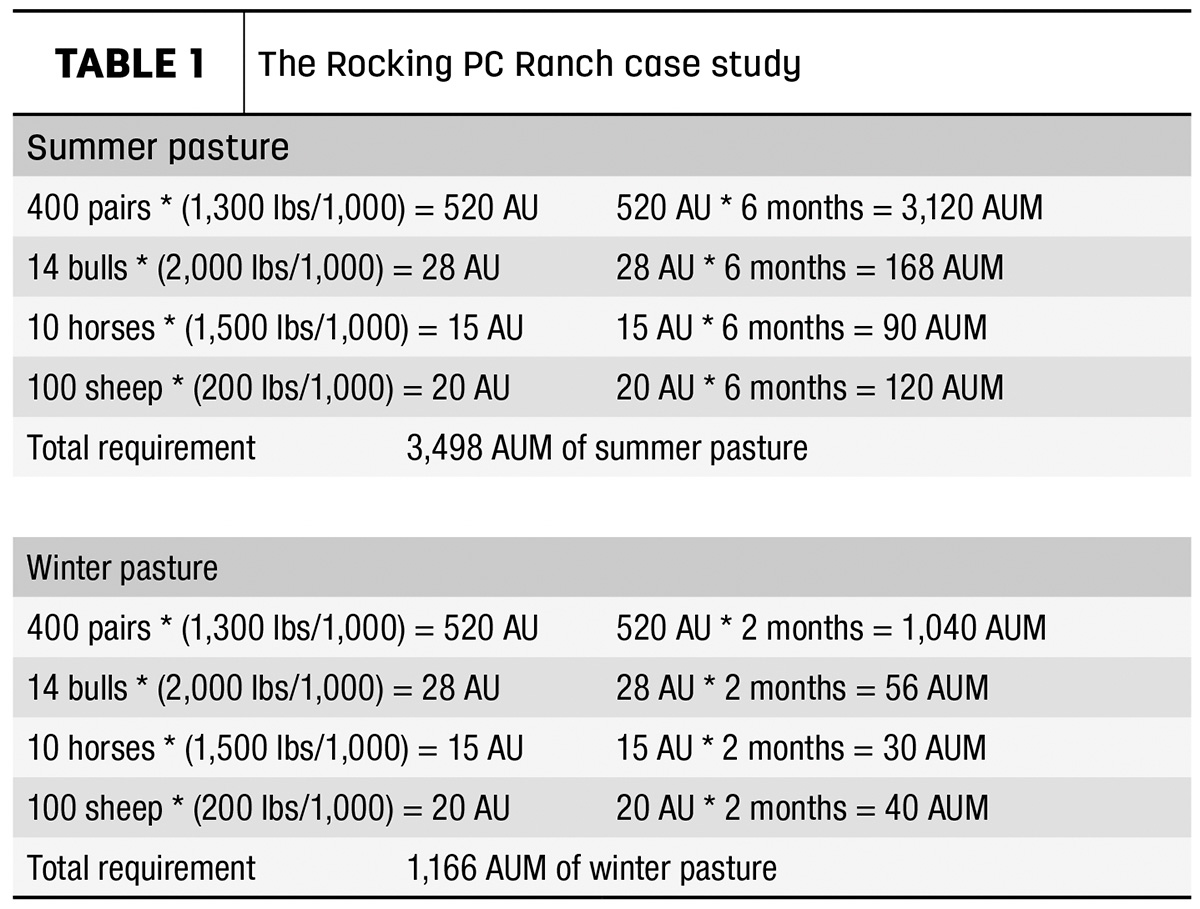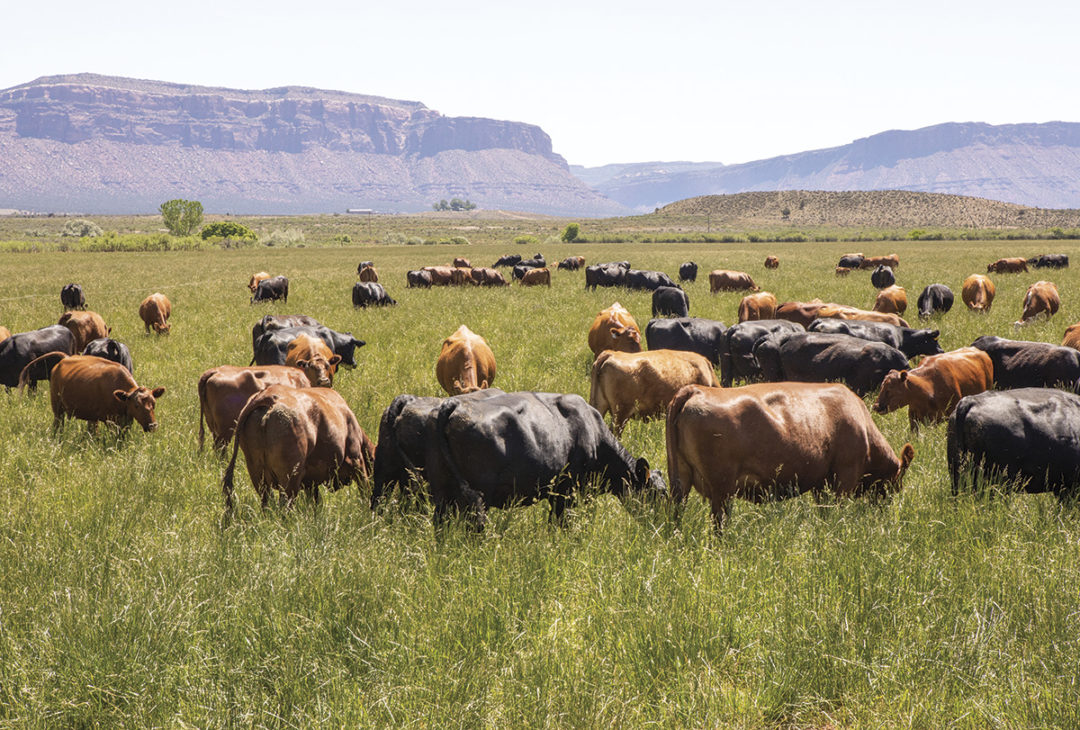Determining how much pasture is needed for summer grazing can be difficult. There are many factors that affect pasture productivity, including last growing season’s conditions. The drought conditions that much of the U.S. experienced last year limited the amount of energy plants were able to store, especially if they were heavily grazed. It is important to consider this when developing a grazing plan for this year. This will aid in understanding how to set stocking rates and prevent further damage.
Many ranchers and government agencies discuss grazing in animal unit months (AUMs); this measurement of forage is confusing for many but provides a standard unit of measurement for forage needs and availability. One AUM is the amount of forage a 1,000-pound animal will eat in a month and changes based on bodyweight, about 780 pounds of air-dry forage (90% dry matter). The equation to convert any weight of animal to a standard animal unit is weight of animal / 1,000 = animal unit equivalent. For example, a yearling weighing 700 pounds is 0.7 animal unit (AU), and a 1,500-pound animal is 1.5 AU.
To help demonstrate how to utilize this math to calculate pasture needs and carrying capacity, here are a couple of case study ranches; the first is the Rocking PC Ranch (Table 1).

This ranch has 400 cows, 14 bulls, 10 horses and a small sheep enterprise. They need to determine how many acres of pasture they will need this year. The Rocking PC has historically had about six months of growing-season grazing and two months of winter grazing; the remaining four months hay is fed.
In the area, forage production averages 1,600 pounds of forage per acre, using the "take half, leave half” rule of thumb – this leaves about 800 pounds of forage for grazing; however, some of this will be lost due to trampling and soiling. For most non-management-intensive rotational grazing systems, the amount of forage actually consumed by the grazers is around 25% to 30%, meaning about 480 pounds per acre is used to feed the animals. Winter-grazed pastures are often grazed more heavily without harming the pasture health. For this example, 50% of winter forage is consumed.
Acres of pasture
3,498 AUM x 780 pounds = 2,728,440 pounds of forage required. If 30% of forage is used as feed, divide by 0.3 to determine total pounds of forage required and then divide by the pounds per acre produced to determine the number of acres. For example, 2,728,440 pounds / 0.3 = 9,094,800 pounds of total forage required / 1,600 pounds per acre = 5,684.25 acres of pasture required for summer grazing.
This same process can be repeated to determine winter grazing acres. 1,166 AUM x 780 pounds = 909,480 pounds / 0.5 = 1,818,960 pounds / 1,600 pounds per acre = 1,136.85 acres of winter pasture.
The total number of pasture acres required by the Rocking PC Ranch is 6,821.1 acres. This does not include hay ground or feed required for the other four months of the winter. This estimation also assumes normal or average conditions. During drought, more acres will be required, or animals may have to be liquidated.
Carrying capacity
This process can also be done in reverse, with a set number of acres to determine the number of animals and amount of time they can be on pasture. A ranch consists of 4,000 acres averaging 1,400 pounds of forage per acre and wants to run some yearlings for five months starting at 600 pounds and selling at 900 pounds (averaging 750 pounds while on pasture).
4,000 acres x 1,400 pounds per acre = 5,600,000 pounds x 0.3 (actual harvest) = 1,680,000 pounds / 780 pounds per AUM = 2,153.85 AUM / 5 months = 430 AU
600 pounds + 900 pounds = 1,500 pounds / 2 = 750 pounds / 1,000= 0.75 AU
430 AU / 0.75 AU = 574 yearlings
Drought management
There are many factors that play into forage production on pasture, especially native rangelands. During periods of drought, forage production can be greatly reduced and can have effects that last into following years, depending on drought severity and management decisions. Knowing and understanding the previous year’s grazing pressure and drought severity aids in assessing how plants will recover after a period of drought. In general, keeping stocking rates lower than normal and increasing rest periods help pasture recover more quickly. Drought severity and grazing pressure should be the driving forces of post-drought management decisions. Having a plan for drought ahead of time is helpful in successfully managing through a drought. If drought conditions persist for multiple years, stocking rates must be reduced to match forage production. There are tools such as GrassCast and NOAA's season-long forecast that can help foresee possible drought conditions coming and help you to start planning for lowering stocking rates ahead of drought. Having set decision points allows you to take some of the emotion out of tough management decisions. Giving your pasture time to recover is imperative after a multiyear drought. Continual pasture condition monitoring and carefully following weather forecasts should help you make informed stocking rate decisions to keep your pasture as productive as possible.








